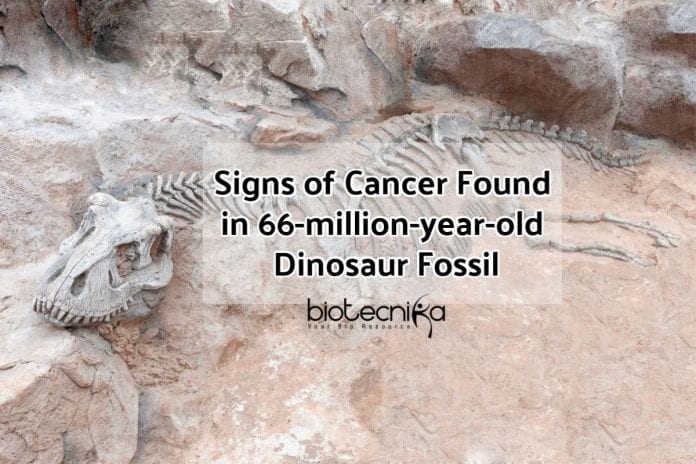Cancer Identified in Dinosaur Fossil
In the fossilized remains of a duck-billed dinosaur that roamed the Earth at least 66 million years ago, a rare disease that still affects humans today has been found.
In southern Alberta, Canada, at the Dinosaur Provincial Park, unusual cavities in two tail segments of the hadrosaur which were unearthed, were noticed by Tel Aviv University researchers. The researchers compared skeletons of two humans who were known to have a benign tumor called LCH (Langerhans cell histiocytosis), a rare and sometimes painful disease that affects children, mainly boys with the vertebrae.
At TAU’s Sackler Faculty of Medicine, the head of the Biohistory and Evolutionary Medicine Laboratory, Dr. Hila May said, “There are some cases where different diseases leave similar marks on bones and thus diagnosing diseases in skeletal remains and fossils is complicated. However, there is a distinctive appearance in the case of LCH and in the lesions found in the hadrosaur, this appearance could be confirmed.” The dinosaur tail fossils were analyzed using high-resolution, advanced CT scans.
May said, “We could examine the structure of the lesion and reconstruct the overgrowth as well as the blood vessels that fed it by using new technologies such
as the micro CT scanning. If this was LCH or not was confirmed by the micro and macro analyses. This disease in a dinosaur has been identified for the first time.”She said, ” In children aged 2-10 years, most of the LCH-related tumors appear suddenly in their bones. Luckily, in many cases, these tumors disappear without any need for intervention.”
Just like us, even dinosaurs got sick but there is no evidence of infection and disease in the fossil record. However, there is evidence that dinosaurs, like the iguanodons, may have had osteoarthritis and the T-rex tyrannosaurids suffered from gout. From the study, we can know that dinosaurs would have suffered from cancer even though cancer has proved more difficult for paleopathologists to diagnose. It is complicated to study disease in fossils, irrespective of the species. When dealing with those of animals that are extinct, we cannot have a living reference and thus, this becomes even more complicated.
We know that many of the diseases we suffer come from animals, such as tuberculosis, HIV and coronavirus. By understanding how the diseases survive evolution and manifest themselves in different species can aid in finding effective and new treatment.
May said, “Knowing that disease is independent of time and species means that the mechanism that encourages its development is a basic problem in an organism’s physiology and is not specific to human behavior and environment.
Editor’s Note: Cancer identified in Dinosaur Fossil






























